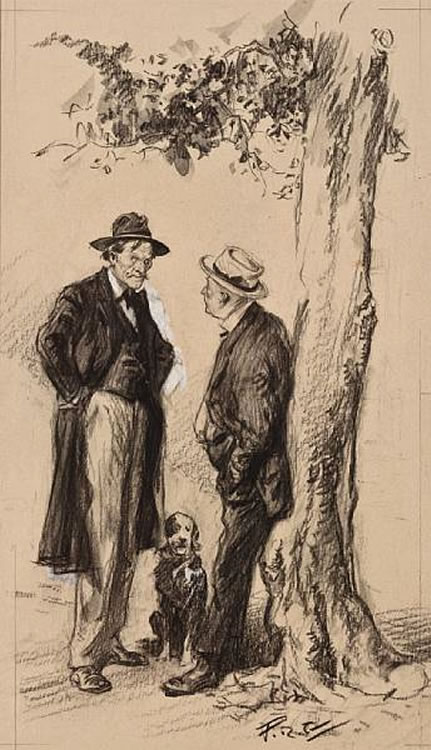"I'll Fill That Old Burglar Full of Holes" Lot no. 897
By Frederic R. Gruger (1871-1953)
1914 (Estimated)
11.13" x 6.44"
Mixed Media on Paper
Signed Lower Right
REQUEST PRICE
PURCHASE REQUEST

F. R. Gruger was one of the most admired artists of the Golden Age of American Illustration. His pictures appeared in almost every major national magazine, but he is best remembered for his long association with The Saturday Evening Post. He was the original illustrator of the serializations of Harry Leon Wilson's Ruggles of Red Gap (1915), Booth Tarkington's Seventeen (1916) and Edna Ferber's Show Boat (1926). Other writers whose work he illustrated during his long career include Bret Harte, Owen Wister, Walter D. Edmunds, P. G. Wodehouse, W. Somerset Maugham, Aldous Huxley, John Galsworthy, Agatha Christie, Ring Lardner, Theodore Dreiser, Sinclair Lewis, F. Scott Fitzgerald, Thomas Wolf and William Faulkner.
Explore related art collections: Magazine Stories / Black & White / Animals / Dogs & Cats / Men / Action / Drama / $100 - $5,000 / Seniors
See all original artwork by Frederic R. Gruger
ABOUT THE ARTIST
Frederic Gruger wrote on the subject of Illustration for the Encyclopedia Britannica, describing the illustrator's role as follows:
"...Illustration may become a great art, but to become a great art, it must be creative. It cannot hope to compete with the camera in the reporting of facts. It has no business with the outer shell of things at all. It deals with the spirit. Dealing with the psychological aspects is a great opportunity and a serious handicap. Presupposing a pictorial presentation of the relations of people, the telling of a story is inevitable. A great and simple story, a kin to truth, or a poor and trivial one, a kin to meagre facts, may be told about the same incident- depending upon the insight, the vision of the artist. The nature of the story portrayed is the measure of the artist who portrays it..."
Gruger demonstrated this insight and vision in his work. His pictures were always concerned with the larger themes, and although the original drawings were actually quite small, they appear monumental in scale. In an era when color was limited, and expensive to reproduce. The majority of Gruger's illustrations were rendered in black and white.
He worked in a medium developed out of his earlier reportorial work for the Philadelphia Ledger. The drawing was made with Wolff pencil, rubbed with a stump or eraser, often over an underlying wash. This combination produced a full range of values, particularly a rich, velvety black. The board he drew on was an inexpensive cardboard used by newspapers for mounting silver prints. It had a receptive, soft surface, and became known as "Gruger board" among the illustrators who adopted it.
Gruger graduated to The Century magazine and worked subsequently for most other publishers and many advertisers, but was most closely identified through his 40-year-long career with The Saturday Evening Post. In 1981, he was elected into the Society of Illustrators Hall of Fame.